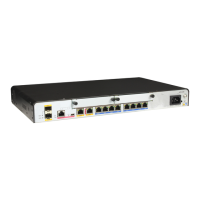Context
A coverage hole is generated when an AP is removed or signals are blocked by an obstacle. An
AP periodically checks for coverage holes. If the AP detects a coverage hole, it calibrates radios
to eliminate the coverage hole.
Procedure
Step 1 Run:
system-view
The system view is displayed.
Step 2 Run:
wlan
The WLAN view is displayed.
Step 3 Run:
radio-profile { id profile-id | name profile-name }
*
A radio profile is created.
After a radio profile is created, parameters in the profile use default values.
Step 4 Run:
channel-mode auto
The automatic channel mode is configured in the radio profile. In this mode, an AP can select a
channel for a radio based on the WLAN radio environment.
An AP periodically checks the network environment to determine whether to adjust its channels
and how to adjust the channels.
Step 5 Run:
power-mode auto
The automatic power mode is configured in the radio profile. In this mode, an AP can set the
transmit power for a radio based on the WLAN radio environment.
An AP periodically checks the network environment to determine whether to adjust the transmit
power so that the entire WLAN can be covered.
Step 6 Run:
calibrate-interval calibrate-interval
Partial radio calibration is enabled and the calibration interval is set.
The calibration function ensures that the transmit power of a radio is not affected by interference
from other radios. An AP checks the radio environment at the specified interval. If the radio
environment deteriorates, the AP calibrates the radio parameters.
----End
1.3.6 Checking the Configuration
After configuring the WLAN radio environment, use the following commands to verify the
configuration.
Huawei AR1200 Series Enterprise Routers
Configuration Guide - WLAN 1 WLAN Configuration
Issue 03 (2012-01-06) Huawei Proprietary and Confidential
Copyright © Huawei Technologies Co., Ltd.
10

